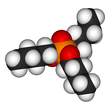
| |||
| |||
| Names | |||
|---|---|---|---|
| Preferred IUPAC name
Tributyl phosphate | |||
| Identifiers | |||
3D model (JSmol)
|
|||
| ChEBI | |||
| ChemSpider | |||
| ECHA InfoCard | 100.004.365 | ||
| KEGG | |||
PubChem CID
|
|||
| UNII | |||
CompTox Dashboard (EPA)
|
|||
| |||
| |||
| Properties | |||
| C12H27O4P | |||
| Molar mass | 266.318 g·mol−1 | ||
| Appearance | Colorless to pale-yellow liquid[1] | ||
| Density | 0.9727 g/mL | ||
| Melting point | −80 °C (−112 °F; 193 K) | ||
| Boiling point | 289 °C (552 °F; 562 K) | ||
| 0.4 g/L[2] | |||
| Vapor pressure | 0.004 mmHg (25°C)[1] | ||
Refractive index (nD)
|
1.4231 (at 20 °C) [3] | ||
| Hazards | |||
| NFPA 704 (fire diamond) | |||
| Flash point | 146.1 °C (295.0 °F; 419.2 K) | ||
| Lethal dose or concentration (LD, LC): | |||
LD50 (median dose)
|
1189 mg/kg (mouse, oral) 3000 mg/kg (rat, oral)[4] | ||
LC50 (median concentration)
|
227 ppm (cat, 4–5 h) 123 ppm (rat, 6 h) 117 ppm (rat) 2529 ppm (rat, 1 h)[4] | ||
LCLo (lowest published)
|
2214 ppm (cat, 5 h)[4] | ||
| NIOSH (US health exposure limits): | |||
PEL (Permissible)
|
TWA 5 mg/m3[1] | ||
REL (Recommended)
|
TWA 0.2 ppm (2.5 mg/m3)[1] | ||
IDLH (Immediate danger)
|
30 ppm[1] | ||
| Safety data sheet (SDS) | External MSDS | ||
Except where otherwise noted, data are given for materials in their standard state (at 25 °C [77 °F], 100 kPa).
| |||
Tributyl phosphate, known commonly as TBP, is an organophosphorus compound with the chemical formula (CH3CH2CH2CH2O)3PO. This colourless, odorless liquid finds some applications as an extractant and a plasticizer. It is an ester of phosphoric acid with n-butanol.
- ^ a b c d e NIOSH Pocket Guide to Chemical Hazards. "#0625". National Institute for Occupational Safety and Health (NIOSH).
- ^ Velavendan, P; Sachithanantham, Ganesh; Pandey, N.K.; Geetha, R; Ahmed, M; Mudali, Kamachi; Natarajan, Rajamani (2012). "Studies on solubility of TBP in aqueous solutions of fuel reprocessing". Journal of Radioanalytical and Nuclear Chemistry. 295 (2): 1113–1117. doi:10.1007/s10967-012-1945-1. S2CID 95976379.
- ^ Pabst, Florian; Blochowicz, Thomas (December 2022). "On the intensity of light scattered by molecular liquids - Comparison of experiment and quantum chemical calculations". The Journal of Chemical Physics. 157 (24): 244501. Bibcode:2022JChPh.157x4501P. doi:10.1063/5.0133511. PMID 36586992.
- ^ a b c "Tributyl phosphate". Immediately Dangerous to Life or Health Concentrations (IDLH). National Institute for Occupational Safety and Health (NIOSH).


